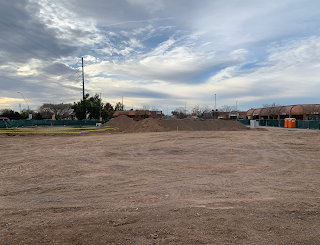Typographical errors in old-time Phoenix
As someone who was a professional graphic designer, specializing in print, I've seen a LOT of typos get into print. Human beings are far from perfect, and at some point the presses have got to roll, and whatever mistakes that were made in the design go onto paper, and stay there, forever.
When books are reprinted, there's an opportunity to make corrections, but if the first printing says "Sunsyslope" like in the Sunnyslope Directory up there from the late 1950s, it can't be corrected. You can't go back and gather up all of the copies, destroy them, and try again. It doesn't work that way.
By the way, if you're wondering why there are so many errors in printed material, actually there really aren't. Someone one explained to me that if a printed piece were done with 99% accuracy, which is pretty high in most industries, it would mean that one word out of one hundred would be misspelled. On the stuff I worked on there was no way to measure the accuracy, but it sure was way higher than 99%! That's why people in the print media tend to be nervous and twitchy!
Anyway, what happens over time is that if something is found in print, people tend to think that it has to be true, like something in a newspaper. But of course you have to consider that newspapers were created by people, and people make mistakes. Newspapers in old-time Phoenix were also created without spell-check, and if you go back far enough in the history of newspapers in Phoenix you will discover that every word had to be set with individual pieces of metal, letter by letter, backwards. The people who set that type must have been amazing, and more than a little bit crazy. Whether the expression "minding your p's and q's" relates to handset type, I really don't know, but if you can imagine it, it must have been quite a trick to get the type set correctly.
With my interest in history I've learned to be prepared to discover that something that I thought was right was actually wrong. And just because something is carved in stone doesn't necessarily mean that it's correct. My own grandmother's headstone got her birthdate wrong by ten years, and that's carved in granite! I always felt sorry for her, everyone thinking that she was ten years older than she really was. But markers cost money, and no one in my family has considered it a worthwhile investment to fix it on her marker.
Like judges, I go with a "preponderance of evidence". And that means that if I have just one source - for example what someone might remember about back in the day, I'm inclined to wait for corroborating evidence. I dislike "circa", so when I date the photos I find I will say "late 1950s", and I know that it could be up to early 1960s, but not early '50s and definitely not '40s or '70s. I've seen the word "circa" abused so much that I've seen World War II photos that were labeled "circa 1930s". And to be fair, that's true, because "circa" gets you off of the hook.
But I strive to be as precise as I can with dates and places. And if someone shows me something in print, I add it to my collection, and it helps, but that's it.
History Adventuring on Patreon
Click here to become a Patron!




Comments
Post a Comment